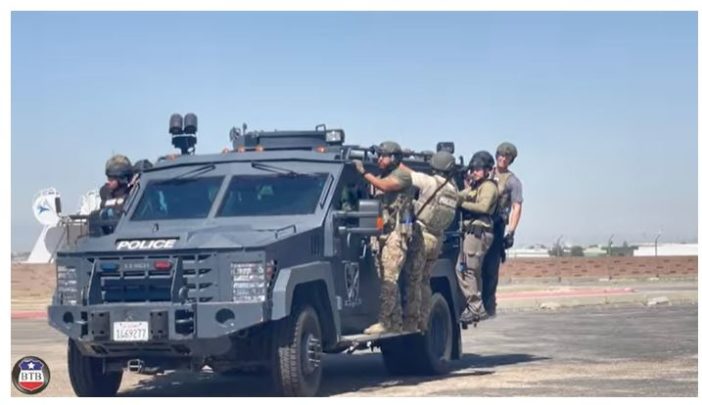We arrived at Bakersfield Police Department’s S.W.A.T (Special Weapons and Tactics) school tucked away in the outskirts of downtown shortly after 8 a.m. We had driven past the city streets, supermarkets, and convenience stores until the landscape turned into peach orchards and open space.
As my colleague and I stepped out of the car, we saw a crowd of police officers dressed in camouflage, wearing bullet proof vests, and scrambling on the roof of a two-story building. It was at this moment I realized I had made a mistake when I put on a pair of sandals to cover this assignment.
Summer sandals, in camel suede with a big gold buckle.
These were not the ideal shoes to wear while trying to shadow dozens of Bakersfield police officers who were training for a worst-case scenario involving an active shooter.
As civilians, we don’t often think about these moments. We don’t think about how to prepare for a terrorist, for a shooting erupting in the middle of an afternoon, or for the level of stress and tension these police officers face when a call comes for the S.W.A.T team.
But for the people training at the Bakersfield Police Department’s S.W.A.T School, this is what it takes to be a part of the team. Knowing at any moment the call can come in and everything you’ve trained for is now real life.
“S.W.A.T School is a two-week program for anyone who makes the team. They all have to train 80 hours beforehand, so every day we are here eight hours a day, producing the most complex scenarios you can think of … everyone gets 15 minutes to produce a plan,” said Bakersfield Police Department Range Master Daniel Champness. “We try to make our scenarios as real as possible, even using blank pellets so if you do get hit, it hurts. It’s a third dimensional puzzle, except people are shooting at you while you try to figure it out.”
For the rest of the morning, my colleague and I followed the officers as they ran around the building, hiding against walls, mounting the armored bearcat, and clamoring off only to climb a wall ladder to the rooftop.
Due to the sandal situation, I crouched in the pitch darkness on the first floor of the building, the lights from the police weapons guiding the way.
I clutched my notepad and pen, and I realized even though I knew this was imaginary play, my heart was racing, my palms were sweaty, and I was afraid. I had a million “what ifs” running through my mind, and the reality was we couldn’t see what was on the other side of the door.
It was the ultimate game of “gotcha,” and tensions were high.
The groups worked together, everyone had their roles, and when given the signal they followed one another through the door.
Someone on the walkie talkie told us where the shooter was hiding and the officer from the drone team maneuvered the aerial through the building, which allowed us to see what was happening inside.
We stood in the dark as police officers went in one by one, checking dark crevices, looking underneath tables, turning corners quickly because they knew someone could be waiting for them.
Despite the high-risk scenario, everyone was quiet and calm as they made their way toward the shooter. I could hear the officers inside the building screaming “put your hands up” which — real or not — made me eternally grateful I was not the first person to walk through the door.
As we crouched behind pillars and cabinets, I looked around hoping someone would give me guidance on the best place to hide as officers screamed “get down” and the sound of pellets as (and life-like) gunfire echoed through the empty building.
I made my way through the room and saw the open door that would lead me back outside. I ran as fast as I could, my sandals flapping.
Once outside, I breathed a sigh of relief.
At the end of the scenario, Bakersfield police officers were triumphant. The barricaded terrorist had been captured after a stand-off that lasted about 15 minutes. Everyone gathered together and talked about what went right or wrong, and the group began to prepare for the next scenario which would commence after lunch.
This was just a day of training for the officers, but for me it was an eye-opening education on what it takes to put on a police uniform.
For many new recruits, joining S.W.A.T is part of the dream of being a police officer. The team has an air of glamour, mystique and of the high-risk and high-reward stakes that make police work fun to watch on television and in the movies.
But as I stood alongside the trainees, it’s clear the job is not for everyone. Police work requires a certain amount of agility, both mentally and physically, in order to succeed. It requires a level of dedication and heroism in its truest form to volunteer to be the first person to burst through a door in a crisis that most of us are running from as fast as we can – even in sandals.
 Behind the Badge
Behind the Badge





